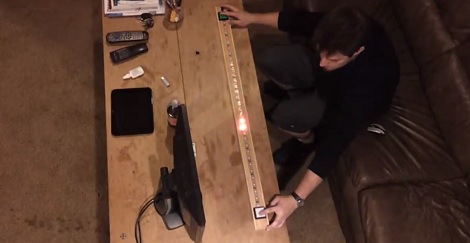
Needing a Christmas present for his 4- and 5-year-old nieces, [John] built a one-dimensional PONG game, sure to be the delight of rosy-cheeked children on a Christmas morn.
The new and improved 1D PONG game is built around a digital RGB LED strip with an LPD8806 LED controller. The speed of the ‘ball’ is controlled by a pot on one side of the game. With each player pressing their button at the right time, the ball bounces back to the other player. Missing the ball awards a point to the other team and most likely an increase in the player’s frustration, greatly increasing the risk of this game being thrown across the room.
While it’s not an obscenely long 1D PONG game like [Jason]’s previous 5 meter version, it’s more than enough to keep a pair of kids occupied for more than a few minutes, a remarkable achievement for just a microcontroller, buttons, and a piece of LED strip.
You can get [John]’s AVR code in this pastebin or just check out the video after the break.














I’m also making a Christmas present this year. Wonder how many other people are making rather than buying this year. Maybe you could have a thread of home-made Christmas presents?
Hackaday staff: please do. You can do that thing you do with topics like Halloween, but with DIY Christmas gifts. :)
I think HAD should do this also, my budget is tight so it may be nice to source ideas for, for a homemade gift!
If each successful return lead to a quicker ball that would actually be a fun game.
As it stands this is not, when I was 2/3 I had Sonic the hedgehog on the Sega Mega Drive.
At 5/6 I was playing ISSS on the Saturn and virtual cop and panzers dragon.
At 8 I was playing GoldenEye on the N64.
These days kids have 3DS, Wii, Xboxs, and PS3, an LED strip would not compete. If it’s price you’re worried about buy them a old Wii or Old DS.
Hi, this is my project. I like your idea of making each successive turn faster and this is easy to do in the code. Maybe I’ll use the pot to set the minimum speed.
As far as buying an old console or handheld; they already have all that stuff, I wanted to make something simple and unique that they would remember.
Also: Thanks for featuring this HAD!
If you had large and tough buttons you could ‘thump’ which would then tell the microcontroller just how hard you hit the button you could vary the speed at which the ‘ball’ is thrown back to the opponent.
That’s a very good idea. Now I’m thinking buttonless knock sensors.
Without having to change the buttons, you could increase the speed when the player hits the button during the sweet spot in the ball’s travel, and maybe decrease it if they hit slightly early or late.
For a variation, make a mat-type button (however like those dance mats work) which the players jump on, the object is to jump “over” the light, timing the jump so that they are off the mat when the light hits it. Like Donkey Kong!
And they have to be back on the mat within however long the average jump time is (a few milliseconds I suppose) to prevent cheating, and when they hit the mat the “ball” is launched in the return direction.
Prevent child hood obesity and introduce kids to video games!
Might be a bit loud though.
Thanks for including my idea John :)
Done. Code with increasing ball speed here: http://pastebin.com/NL0BypG4
I don’t know man. I remember getting a NES on year and the year after that I got a cardboard box (cut out like a club house)! I was very happy with the cardboard box!
Yeah this is cool. I can see a couple of young kids spending some time playing. Heck I can see adults playing a bit as well. Plus it is unique.
I second the comment buy Dustin, about a thread for hacks being presents this year. Could be a fun read.
when i saw this i thought: anti-drunk-driving interlock !
score a 8 / 10 or higher to enable starting car
now my cofee table needs a CANBUS dongle… lol
*Coffee, also I’m not a Grammar Nazi I just see this misspelled a lot and try to correct it.
When a point is won you could show the score of the player that has just won the point on the led strip itself.
We actually built something very similar as part of a sequential logic project in our Intro to Digital Systems class back at university. The only difference was that you could only use discrete gates (7400 series if I remember correctly).
Would be a fun bar game. Sitting at the bar with a beer and playing a bit of simple pong
I’ve got some adafruit pixels sitting around and 2 trees in the front yard. I think I need to make a yard-scale version of this
I had one of these when I was a kid. The closer you let the “ball” get to you, the faster it returned to the other player. And in advanced modes, the speed of the ball accumulated.
A ball moving along a line exists in two dimensions. To be one dimensional it would need to be stationary at a single point.